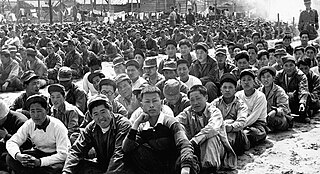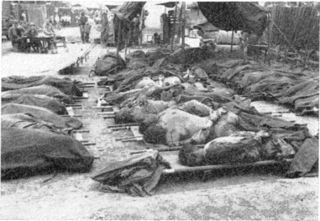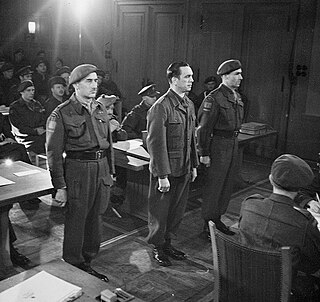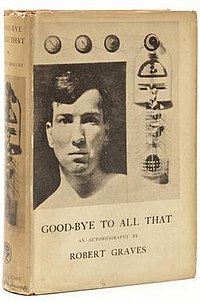
A prisoner of war (POW) is a person who is held captive by a belligerent power during or immediately after an armed conflict. The earliest recorded usage of the phrase "prisoner of war" dates back to 1610.

Captain Robert von Ranke Graves was an English poet, historical novelist and critic. His father was Alfred Perceval Graves, a celebrated Irish poet and figure in the Gaelic revival; they were both Celticists and students of Irish mythology.

Siegfried Loraine Sassoon was an English war poet, writer, and soldier. Decorated for bravery on the Western Front, he became one of the leading poets of the First World War. His poetry both described the horrors of the trenches and satirized the patriotic pretensions of those who, in Sassoon's view, were responsible for a jingoism-fuelled war. Sassoon became a focal point for dissent within the armed forces when he made a lone protest against the continuation of the war with his "Soldier's Declaration" of July 1917, which resulted in his being sent to the Craiglockhart War Hospital. During this period he met and formed a friendship with Wilfred Owen, who was greatly influenced by him. Sassoon later won acclaim for his prose work, notably his three-volume, fictionalised autobiography, collectively known as the Sherston trilogy.

Wilfred Edward Salter Owen MC was an English poet and soldier. He was one of the leading poets of the First World War. His war poetry on the horrors of trenches and gas warfare was much influenced by his mentor Siegfried Sassoon and stood in contrast to the public perception of war at the time and to the confidently patriotic verse written by earlier war poets such as Rupert Brooke. Among his best-known works – most of which were published posthumously – are "Dulce et Decorum est", "Insensibility", "Anthem for Doomed Youth", "Futility", "Spring Offensive" and "Strange Meeting". Owen was killed in action on 4 November 1918, a week before the war's end, at the age of 25.

Edmund Charles Blunden was an English poet, author, and critic. Like his friend Siegfried Sassoon, he wrote of his experiences in World War I in both verse and prose. For most of his career, Blunden was also a reviewer for English publications and an academic in Tokyo and later Hong Kong. He ended his career as Professor of Poetry at the University of Oxford. He was nominated for the Nobel Prize in Literature six times.

Regeneration is a historical and anti-war novel by Pat Barker, first published in 1991. The novel was a Booker Prize nominee and was described by the New York Times Book Review as one of the four best novels of the year in its year of publication. It is the first of three novels in the Regeneration Trilogy of novels on the First World War, the other two being The Eye in the Door and The Ghost Road, which won the Booker Prize in 1995. The novel was adapted into a film by the same name in 1997 by Scottish film director Gillies MacKinnon and starring Jonathan Pryce as Rivers, James Wilby as Sassoon and Jonny Lee Miller as Prior. The film was successful in the UK and Canada, receiving nominations for a number of awards.

The Bataan Death March was the forcible transfer by the Imperial Japanese Army of 75,000 American and Filipino prisoners of war (POW) from the municipalities of Bagac and Mariveles on the Bataan Peninsula to Camp O'Donnell via San Fernando.

Tomoyuki Yamashita was a Japanese convicted war criminal and general in the Imperial Japanese Army during World War II. Yamashita led Japanese forces during the invasion of Malaya and Battle of Singapore, with his accomplishment of conquering Malaya and Singapore in 70 days earning him the sobriquet "The Tiger of Malaya" and led to the British Prime Minister Winston Churchill calling the ignominious fall of Singapore to Japan the "worst disaster" and "largest capitulation" in British military history. Yamashita was assigned to defend the Philippines from the advancing Allied forces later in the war, and while unable to prevent the Allied advance, he was able to hold on to part of Luzon until after the formal Surrender of Japan in August 1945.

Disarmed Enemy Forces is a US designation for soldiers who surrender to an adversary after hostilities end, and for those POWs who had already surrendered and were held in camps in occupied German territory at the time. It was General Dwight D. Eisenhower's designation of German prisoners in post–World War II occupied Germany.

A prisoner-of-war camp is a site for the containment of enemy fighters captured by a belligerent power in time of war.
During World War II, the Allies committed legally proven war crimes and violations of the laws of war against either civilians or military personnel of the Axis powers. At the end of World War II, many trials of Axis war criminals took place, most famously the Nuremberg Trials and Tokyo Trials. In Europe, these tribunals were set up under the authority of the London Charter, which only considered allegations of war crimes committed by people who acted in the interests of the Axis powers. Some war crimes involving Allied personnel were investigated by the Allied powers and led in some instances to courts-martial. Some incidents alleged by historians to have been crimes under the law of war in operation at the time were, for a variety of reasons, not investigated by the Allied powers during the war, or were investigated but not prosecuted.

The Utah prisoner of war massacre took place after the end of World War II in Europe at midnight on July 8, 1945, at a German and Italian prisoner-of-war camp in Salina, Utah. Nine German prisoners of war were murdered and nineteen prisoners were wounded by American private Clarence V. Bertucci, who was on active duty in the camp. After a night out, Bertucci returned to camp around midnight to assume his night duty at the guard tower. Bertucci subsequently loaded the .30-caliber M1917 Browning machine gun on the tower and fired at the tents of the sleeping prisoners. After the massacre, he revealed his motivation was that, "he had hated Germans, so he had killed Germans." Six Germans were immediately killed, two died in Salina's hospital, one died in an army hospital, and nineteen were wounded.

The Ardenne Abbey massacre occurred during the Battle of Normandy at the Ardenne Abbey, a Premonstratensian monastery in Saint-Germain-la-Blanche-Herbe, near Caen, France. In June 1944, 20 Canadian soldiers were massacred in a garden at the abbey by members of the 12th SS Panzer Division Hitlerjugend over the course of several days and weeks. This was part of the Normandy Massacres, a series of scattered killings during which up to 156 Canadian prisoners of war were murdered by soldiers of the 12th SS Panzer Division during the Battle of Normandy. The perpetrators of the massacre, members of the 12th SS Panzer Division, were known for their fanaticism, the majority having been drawn from the Hitlerjugend or Hitler Youth.

During World War II, the German Wehrmacht committed systematic war crimes, including massacres, mass rape, looting, the exploitation of forced labor, the murder of three million Soviet prisoners of war, and participated in the extermination of Jews. While the Nazi Party's own SS forces was the organization most responsible for the genocidal killing of the Holocaust, the regular armed forces of the Wehrmacht committed many war crimes of their own, particularly on the Eastern Front.


The Crucified Soldier was the widespread story of an Allied soldier serving in the Canadian Corps who may have been crucified with bayonets on a barn door or a tree, while fighting on the Western Front during World War I. Three witnesses said they saw an unidentified crucified Canadian soldier near the battlefield of Ypres, Belgium, on or around 24 April 1915, but eyewitness accounts were somewhat contradictory, no crucified body was recovered and the identity of the crucified soldier was not discovered at the time.

During World War II, it was estimated that between 35,000 and 50,000 members of the Imperial Japanese Armed Forces surrendered to Allied servicemembers prior to the end of World War II in Asia in August 1945. Also, Soviet troops seized and imprisoned more than half a million Japanese troops and civilians in China and other places. The number of Japanese soldiers, sailors, marines, and airmen who surrendered was limited by the Japanese military indoctrinating its personnel to fight to the death, Allied combat personnel often being unwilling to take prisoners, and many Japanese soldiers believing that those who surrendered would be killed by their captors.

The Hill 303 massacre was a war crime that took place during the opening days of the Korean War on August 17, 1950, on a hill above Waegwan, Republic of Korea. Forty-one United States Army (US) prisoners of war were murdered by troops of the North Korean People's Army (KPA) during one of the engagements of the Battle of Pusan Perimeter.

Members of the German military were interned as prisoners of war in the United States during World War I and World War II. In all, 425,000 German prisoners lived in 700 camps throughout the United States during World War II.

The Normandy massacres were a series of killings in-which approximately 156 Canadian and two British prisoners of war (POWs) were murdered by soldiers of the 12th SS Panzer Division during the Battle of Normandy in World War II. The majority of the murders occurred within the first ten days of the Allied invasion of France. The killings ranged in scale from spontaneous murders of individual POWs, to premeditated mass executions. Colonel Kurt Meyer, a commander in the 12th SS Panzer Division, was the only perpetrator charged for his role in the atrocities.



















